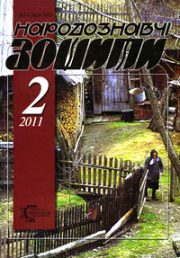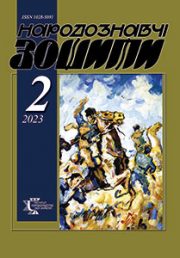The Ethnology Notebooks. 2024. № 3 (177), 539—561
UDK 94:[911.53:574:398.344](=1:477.8:292.452)
DOI https://doi.org/10.15407/nz2024.03.539
BOYKO Ihor
- ORCID ID: https://orcid.org/0000-0002-3828-1835
- Candidate of Historical Sciences, Researcher, Institute of Ethnology
- of the National Academy of Sciences of Ukraine,
- Prospekt Svobody, 15, 79000, Lviv, Ukraine,
- Contacts: e-mail: ihor.o.bojko@gmail.com
Abstract. The classical differentiation of sciences, which resulted in the development of specific methodological principles, terminologies, instrumentality, etc., obviously played a positive role in the development of science, when scientists asked questions: «What is this? Where is it common? How can it be used, or how can it be avoided or prevented?» In the future, due to the accumulation of practical and theoretical knowledge, the emergence of new challenges to society, appeared the need to understand the deep nature of phenomena, control over them, design and restoration of the environment, treatment of society and nature, scientific forecasting, etc. This led to the realization of the falsity of any determinism, requiring the use of data from different sciences, the creation of common scientific approaches and interdisciplinary approaches. One of such relevant approaches is the ecosystem approach, which is developing within the science of ecology, as well as at the junction of this science and many others, in particular socio-cultural anthropology. However, an obstacle to the effective application of the ecosystem approach is the misunderstanding of terms, inconsistency of methodology, which arise between representatives of different sciences. All this reduces the effectiveness and practical significance of the ecosystem approach, sometimes leads to wrong conclusions, and most importantly, it does not allow the use of research results by representatives of other sciences.
An important component of the traditional culture of the Carpathian population is the remote household, which is used in various ecological niches, is a component and creative principle of many anthropo-ecosystems, the so-called sub-ecumene. The author analyzes various theoretical developments in the field of the ecosystem approach, tries to find a common denominator. Therefore, on the basis of this, he distinguishes different types of sub-ecumenes, analyzes the landscape ecosystems of the Ukrainian Carpathians. The subject of the article is the peculiarities of applying the ecosystem approach in the study of the traditional culture of the Carpathian population. The object of the study is a remote household of the Carpathian population. The purposeis to analyze the impact of remote farming on the features of the landscape ecosystems of the Ukrainian Carpathians. The chronological frameworkof the study covers the first half of the 20th century.
Keywords: anthropo-ecosystem, sub-ecumene, remote household, Carpathians, cultural landscape.
Received 16.04.2024
REFERENCES
- Kyselyov, M., & Popovitch, M. (Ed.). (2010). The concept of «unified science»: philosophical and methodological aspect. In: M. Popovitch. Philosophical dialogues (Issue 4, part 1, pp. 122—138). Kyiv [in Ukrainian].
- Jerabek, H. (1993). Classic sociological research (Pр.27—33).Praha[in Czech].
- Boyko, I. (2013). Formation of ethnoecology and its prospects in Ukrainian science. The Ethnology notebooks, 2 (110), 256—265 [in Ukrainian].
- Bilyavskyi, G.O., & Brovdiy, V.M. (1995). On the classification of the main areas of modern ecology. Native nature, 2, 4—7 [in Ukrainian].
- Golubets, M.A. (2000). Ecosystemology. Lviv: Polly [in Ukrainian].
- Melnyk, Ya. (2012). Ecology of man and culture in the context of the evolution of cultural and political metamorphoses. Ethnicity and culture, 9, 70—78 [in Ukrainian].
- Boyko, I. (2023). Integration of natural science and socio-humanitarian branches of science on the example of the study of traditional nature management of mountain areas. Ethnological notebooks, 2 (170), 314—323 [in Ukrainian]
- Fedorov, V.D., & Gilmanov, T.G. (1980). Ecology. Moscow: Research Institute of Moscow State University [in Russian].
- Odum, Ju. (1986). Jekologija (Vol. 1). Moscow: Mir [in Russian].
- Tansley, A.G. (1935). The use and abuse of vegetational concepts and terms. Ecology, 16, 284—307.
- Reimers, N.F., & Yablokov, A.V. (1982). Dictionary of terms and concepts related to wildlife conservation. Moscow: Nauka [in Russian].
- Vinichuk, M. (1921). General ecology: study guide. Zhytomyr: Publishing House; Zhytomyr Polytechnic State University [in Ukrainian].
- Kruglov, I. (1999). Teaching about landscape as a single geography. Landscape as an integrating concept of the 21st century. Collection of scientific works (Pp. 26—33). Kyiv [in Ukrainian].
- Kistowski, M. Understanding of landscape by geographers — naturalists. Retrieved from: https://arch.pg.edu.pl/documents/10613/73017270/M_Kistowski_rozumienie%20krajobrazu%20przez%20geograf%C3%B3w- przyrodnik%C3%B3w.pdf (Last accessed: 21.05.2023).
- Naіkowski, W., & Arct, M. (Ed.). (1925). Outline of geography methodology. Warsawa [in Polish].
- Nowakowski, S. (1936). Geography as a science and the history of geographical discoveries. Warsawa: Published by Trzaska, Evert and Michalski [in Polish].
- Grigoriev, A.A. (1922). Economic geography as a geographical discipline and issues of regionalization. Geographical Bulletin (Issue 3/4, pp. 16—21) [in Russian].
- Schluter, O. (1928). The analytical geography of the cultural landscape. Journal of the Society for Geography in Berlin. Special volume (Pp. 387—411) [in German].
- Berg, L.S. (1915). Subject and tasks of geography. News from IRGO (Vol. 51 (9), pp. 463—475) [in Russian].
- Isachenko, A.G. (1973). To the study of the history of geographical ideas (response to Yu.G. Saushkin). News of the All-Union Geographical Society, 6, 523—527 [in Russian].
- Milkov, F.N. (1977). Anthropogenic landscape science: subject of study and current state. Issues of geography: Human influence on landscapes (Issue 106, pp. 11—27) [in Russian].
- Kistowski, M. (2008). The concept of landscape balance — myths and reality. The structure and functioning of landscape systems. Meta-analyses, models, theories and their applications. Problems of Landscape Ecology (Vol. XXI, pp. 81—91). Lublin [in Polish].
- Reimers, N.F. (1994). Ecology. Theories, laws, rules, principles and hypotheses. Moscow [in Russian].
- Cultural landscape. Retrieved from: https://uk.wikipedia. org/wiki/%D0%9A%D1%83%D0%BB%D1%8C% D1%82%D1%83%D1%80%D0%BD% D0%B8%D0%B9_%D0%BB%D0%B0%D0%BD%D0%B4%D1%88%D0%B0%D1%84%D1%82 (Last accessed: 19.07.2021).
- Bezlatnya, L.O. (2014). The concept of «cultural landscape»: essence, scope of application. Scientific notes of Vinnytsia State Pedagogical University named after Mykhailo Kotsyubynskyi. Series: Geography (Issue 26, pp. 127—132) [in Ukrainian].
- Kovalchuk, I.P. (2010). Current issues of knowledge and construction of cultural (civilized) landscapes. Scientific notes of the Vinnytsia Pedagogical University: Ser. Geography (Issue 21, pp. 118—125) [in Ukrainian].
- Kalutskov, V.N. (2000). Fundamentals of ethnocultural landscape studies: textbook. Moscow: Moscow University Publishing House [in Russian].
- Grodzinsky, M.D. (2005). Knowledge of the landscape: place and space: a monograph: in the 2 vol. (Vol. 2). Kyiv: Kyiv University Publishing and Printing Center [in Ukrainian].
- Volovik, V.M. (2013). Ethnocultural landscapes: regional structures and nature use. Vinnytsia: Vinnytsia City Printing House [in Ukrainian].
- Hrymych, M. (Ed.) (2017). Cultural landscape of Kyiv and its surroundings. Anthropology of space (Vol. 1). Kyiv [in Ukrainian].
- Greider, T., & Garkovich, L. (1994). Landscapes: the Social Construction of Nature and the Environment. Rural Sociology, 59 (1), 1—24.
- Martinenaite, L. (2011). Landscape and its theoretical interpretations. Folk Art and ethnology, 3, 91—95 [in Ukrainian].
- Hardesty, D.L., Alanen, A.R., & Melnick, R.Z. (Ed.). (2000). Ethnographic landscapes: transforming nature into culture. In: A.R. Alanen, R.Z. Melnick. Preserving Cultural Landscapes in America (Pp. 169—185). Baltimore; London: Johns Hopkins University Press.
- Evans, M.J., Roberts, A., & Nelson, P. (2001). Ethnographic Landscapes. Retrieved from: http://crm.cr.nps.gov/archive/24-05/24-05-20.Pdf (Last accessed: 04.05.2021).
- Dobrowolska, M. (1948.). Dynamics of cultural landscape. Geographical Review, 1 (25), 152—203 [in Polish].
- Arnold, S. (1951). Historical geography of Poland. Warsaw: National Scientific Publishing House [in Polish].
- Myga-Piatek, U. (2001). Dispute over the concept of landscape in geography and related fields. Geographic Review, 73 (1—2), 163—176 [in Polish].
- Andrejczuk, W. (2013). Functions of the cultural landscape. Works of the Cultural Landscape Commission, 20, 65—81 [in Polish].
- Myga-Piatek, U. (2014). Natural, anthropogenic and cultural landscape an attempt to define mutual relations and the scope of notions. Dissertations of cultural landscape commission, 23, 39—56.
- Czepczyсski, M. (2006). Transformations of Central European cultural landscapes. Between circulations and iconography. Bulletin of Geography socio-economic series, 6, 5—15.
- Rembowska, K. (2002). Culture in tradition and in contemporary trends in geographical research. Lodz: Lodz University Publishing House [in Polish].
- Neef, E. (1967). The theoretical foundations of landscape theory. Gotha; Leipzig: Hermann Haack: Geographical-Cartographic Institute [in German].
- Naveh, Z. (1987). Biocybernetics and thermodynamic perspectives of landscape functions and land use patterns. Landscape ecology, 1, 75—83.
- Marinelli, O. (1902). Orographic studies in the Eastern Alps. Italian Geographical Society. Series 4 (Vol. 3, pp. 682—716) [in Italian].
- Schumann, A. (1912). The upper settlement limit on the northern edge of the German low mountain range (Part I: The Cebirgc west of the Elbe). Leipzig [in German].
- Lehmann, O. (1913). The concept of the upper settlement limit, its origin, its methods of determination and its geographical value. Vienna [in German].
- Lehmann, O. (1920). Further development of the concept of the upper limit of permanent settlements in the Alps. Communications from the Geographical Society. Vienna [in German].
- Krebs, N. (1912). The inhabited and uninhabited areas of the Eastern Alps. Geographical magazine (Vol. XVIII, pp. 443—454) [in German].
- Kubijowycz, W. (1929). The upper limit of settlement in the Bystrzyca Nadwуrniaсska valley. Krakow [in Polish].
- Kubijowycz, W. (1920—1921). A contribution to the anthropogeography of the Gorgans. Geographic Review (Pp. 146—149) [in Polish].
- Kubijowycz, W. (1927). Shepherd life in the Beskids Magorski. Krakow [in Polish].
- Holub-Pacewiczowa, Z. (1928). Shepherd life in the Tatra Mountains. Krakow: Published by the Polish Academy of Learning [in Polish].
- Solomin, G.S. (pseudonym), & Delyusin, L.P. (Ed.). (1976). To the analysis of the views of Ku Hung-ming. In: L.P. Delyusin. China: traditions and modernity (Pp. 153—167). Moscow: Main editorial office of oriental literature of the Nauka publishing house [in Russian].
- Chepa, M.-L.A. (Ed.). (2015). Synergetic vision of the ways of synthesis of East and West. Psychological regularities of implementation of constructive functions of ethnoculture in the information society: monograph (Pp. 20—32). Kyiv [in Ukrainian].
- Suvorkina, E.N. (2012). Subculture of childhood as a model of the autonomous reality of childhood. Bulletin of the Ryazan State University, 36. Retrieved from: https://cyberleninka.ru/article/n/subkultura-detstva-kak-model-avtonomnoy-realnosti-detstva (Last accessed: 02.03.2023) [in Russian].
- Savchuk, I.G. Oikumen Dictionary of social geography. Retrieved from: https://geohub.org.ua/node/4422 (Last accessed: 02.03.2023) [in Ukrainian].
- Boguszewicz, A., Boguszewicz, M., & Wisniewska, D. (Ed.). (2000). From the research on the changes in the settlement in the Silesian Sudetes in the 12 th—13th centuries). In: M. Boguszewicz, A. Boguszewicz, D. Wisniewska. Man and the environment in the Sudetes (Pp. 151—168). Wroclaw: Regionalny Osrodek Studiow i Ochrony Srodowiska Kulturowego [in Polish].
- Distribution of population in the world — ecumene, subecumene, anecumene — examples, definition. Retrieved from: https://eszkola.pl/geografia/rozmieszczenie-ludnosci-na-swiecie-5391.html (Last accessed: 01.03.2023) [in Polish].
- Halas, M., Brychtova, S., & Fnukal, M. (2013). Basics of human geography 1: Geography of population and settlements. Olomouc [in Czech].
- Geographical dictionary of the Kingdom of Poland. (1880—1914): Vol. 12 (pp. 311, 408, 516, 597, 665, 724, 847); Vol. 13 (pp. 247, 683, 891); Vol. 5 (pp. 94, 142, 204, 205, 284, 692, 921); Vol. 3 (pp. 110, 112, 113, 701); Vol. 10 (pp. 62, 91, 363, 473, 766, 907—908); Vol. 8 (pp. 366, 562, 564); Vol. 7 (pp. 539, 573, 596); Vol. 11 (pp. 267, 536, 559, 744, 909); Vol. 2 (pp. 106, 773, 777); Vol. 3 (pp. 83, 226, 257, 342, 396, 468); Vol. 1 (pp. 66, 256, 278, 484); Vol. 6 (p. 880); Vol. 4 (pp. 299, 301, 420, 767); Vol. 9 (p. 855); Vol. 14 (pp. 120, 149, 842, 854). Warsaw: Published by Filip Sulimierski and Wіadysіaw Walewski [in Polish].
- Kubijovyc, V. (1932). Expansion of cultures and population in the Northern Carpathians. Bratislava [in Czech].
- Trokhimchuk, S.V. (1968). Changing landscapes of the Stryi-San Upland in the Ukrainian Carpathians during historical time. (PhD dissertation). Faculty of Geography of Ivan Franko Lviv National University [in Ukrainian].







